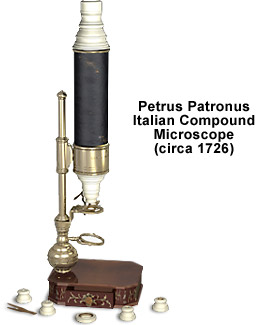Petrus Patronus Italian Compound Microscope
The brass ball joint and pillar of this microscope resemble similar pieces from models fabricated by John Marshall of London during the late seventeenth and early eighteenth century. Signed "Petrus Patronus, 1726", the microscope is equipped with several accessories including iron and brass tweezers and auxiliary objectives. Gerard Turner has described the construction and history of this microscope in fine detail.

The long and narrow body tube is fashioned from thin wood and lined with paper, with an external covering of black leather. The eyepiece, a double convex lens protected by an eye cap, and nosepiece are made of turned ivory. A brass pillar is attached to a wooden base with a large ball-and-socket joint and supports a brass sleeve that holds the body tube support collar. Focusing positions (1 through 4) are stamped onto the sleeve, which is secured to the pillar with a turn-screw.
The circular stage is fastened to the pillar through a sleeve and nut and contains specimen clips with a fitting for stage forceps. Beneath the stage is a double planar mirror that is pinned to the base of the pillar. Illustrated around the wooden microscope base are a series of objectives having lenses mounted in turned ivory housings. The base in the original microscope is made of soft wood and painted black with a chinoiserie-pattern decoration. Lead weights have been added to the base in order to stabilize the microscope. A small drawer in the base is utilized to house accessories.
Coarse focus is achieved by moving the entire microscope body upward or downward on the pillar to crudely position the microscope for specimen observation. Fine specimen details can be brought into focus by means of an octagonal knob positioned at the top of the pillar, which acts as a fine focus control by moving a long iron rod tensioned by a brass spring.
BACK TO EIGHTEENTH CENTURY MICROSCOPES
